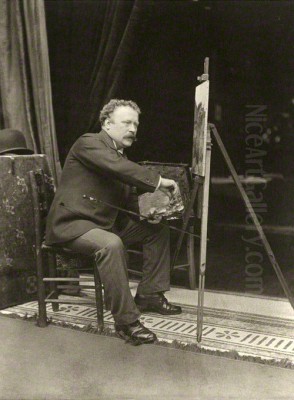
Henry Woods RA (Royal Academician) was a distinguished British painter of the late Victorian and Edwardian eras, celebrated primarily for his evocative and picturesque depictions of Venetian life. While perhaps not as revolutionary as some of his contemporaries, Woods carved a significant niche for himself, capturing the charm, vibrancy, and everyday narratives of Venice with a skilled hand and a keen observational eye. His work resonated deeply with the British public, offering them a sun-drenched escape to the romantic canals and bustling piazzas of La Serenissima.
Henry Woods (1846-1921): A Basic Biography
Henry Woods was born on April 22, 1846, in Warrington, Lancashire, England. His father, Joseph Woods, was a pawnbroker, and his mother, Fanny, was an amateur artist, which likely provided an early artistic influence. Young Henry's artistic talents were recognized early, leading him to study at the Warrington School of Art. His promise was such that he was awarded a government scholarship, enabling him to move to London in 1865 to further his studies at the South Kensington Schools (now the Royal College of Art).
At South Kensington, Woods formed a close and lifelong friendship with fellow student Luke Fildes. This friendship would prove pivotal in both their personal and professional lives. After completing their studies, both Woods and Fildes began their careers as illustrators for various popular periodicals, most notably The Graphic. This work provided them with a steady income and honed their skills in narrative composition and capturing character, elements that would become hallmarks of their later paintings.
The allure of continental Europe, particularly Italy, was strong for many British artists of this period. In 1876, Woods made his first visit to Venice, accompanying Luke Fildes and Fildes's wife Fanny (who was Henry Woods's sister). This trip was a revelation for Woods. He was captivated by the city's unique atmosphere, its luminous light, its decaying grandeur, and the vibrant life of its inhabitants. This initial encounter with Venice profoundly shaped the trajectory of his artistic career.

So enchanted was Woods by Venice that he decided to make it his primary residence. From the late 1870s onwards, he spent the greater part of each year in the city, establishing a studio there. He initially shared a studio with the Belgian painter Van Haanen and later acquired his own, the Palazzo Vendramin Calergi being one of his known addresses, and later a studio near San Barnaba. Despite living abroad, Woods maintained strong ties with the British art world, regularly sending his Venetian scenes back to London for exhibition.
He achieved considerable success and recognition. Woods was elected an Associate of the Royal Academy (ARA) in 1882 and a full Royal Academician (RA) in 1893, prestigious honors that cemented his status within the British art establishment. He continued to paint and exhibit prolifically until his later years. Henry Woods passed away in Venice on October 27, 1921, the city that had become his muse and his home. He is buried in the Protestant Cemetery in Venice.
Henry Woods's Main Artistic Style and Creative Themes
Henry Woods's artistic style is firmly rooted in the Victorian academic tradition. His paintings are characterized by careful draughtsmanship, a high degree of finish, and a commitment to realistic representation. He was a skilled observer, and his works are filled with meticulously rendered details of Venetian architecture, costume, and daily life. His training as an illustrator for publications like The Graphic undoubtedly contributed to his ability to construct clear, legible, and engaging narrative scenes.
The primary theme that dominated Woods's oeuvre was Venetian genre painting. He sought to capture the everyday life of ordinary Venetians – market sellers, flower girls, gossiping women, courting couples, families, and fishermen. Unlike some artists who focused on the grand historical or mythological subjects favored by the high academic tradition, Woods found his inspiration in the contemporary life unfolding around him in the campi (squares), calli (streets), and canals of Venice.
His approach was often picturesque and anecdotal. He presented Venice not as a city of overwhelming drama or deep social commentary, but as a place of charm, beauty, and gentle human interaction. His figures are typically attractive and engaging, and his scenes are bathed in the warm, golden light for which Venice is famous. This romanticized yet relatable vision of Venice proved immensely popular with British audiences, who were fascinated by foreign lands and cultures, particularly the perceived romance of Italy.
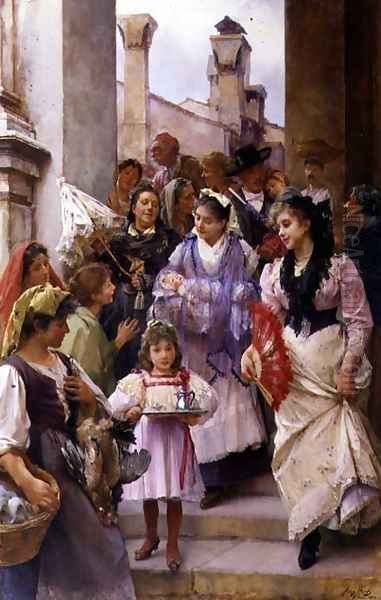
Woods's use of color was vibrant and luminous, reflecting the unique interplay of light and water in Venice. He paid close attention to the textures of fabrics, the weathered surfaces of buildings, and the shimmering reflections on the canals. While his style was predominantly realistic, there is often a sentimental or charming quality to his work that appealed to Victorian sensibilities. He was less interested in the avant-garde movements like Impressionism that were developing during his career, preferring to work within the established conventions of narrative realism.
His contemporaries who also specialized in Venetian scenes, such as the Austrian painter Eugene de Blaas (Eugen von Blaas), often shared a similar focus on attractive local figures and charming vignettes, though de Blaas's work could sometimes be more overtly sensual or sentimental. Woods's friend, Luke Fildes, also painted Venetian subjects, particularly in his earlier career, often with a similar attention to detail and character. However, Fildes later became more known for his social realist works and portraiture in Britain. Other British artists like William Logsdail also found success painting Venetian scenes, sometimes with a greater emphasis on architectural accuracy or broader cityscapes.
Woods's contribution lies in his consistent and dedicated portrayal of a specific aspect of Venetian life, creating a body of work that, while not groundbreaking in terms of artistic innovation, offers a delightful and enduring window into the Venice of his time. He captured a sense of place and the character of its people with affection and skill, making him one ofthe foremost British painters of Venetian genre.
A List of Henry Woods's Representative Works and Their Creative Background
Henry Woods produced a considerable body of work, with many of his paintings depicting the sunlit charm of Venetian life. His creative background was his deep immersion in the city, his keen observation of its people, and his desire to translate these experiences into appealing visual narratives for his audience back in Britain.
One of his notable early successes was "At the Foot of the Rialto" (1880). This painting, exhibited at the Royal Academy, showcases a bustling scene near the famous Rialto Bridge. It features a variety of figures – vendors, shoppers, and passersby – all engaged in their daily activities. The composition is lively, and the details of the architecture and the figures' attire are carefully rendered. The painting captures the vibrant commercial heart of Venice and was well-received for its authenticity and charm.
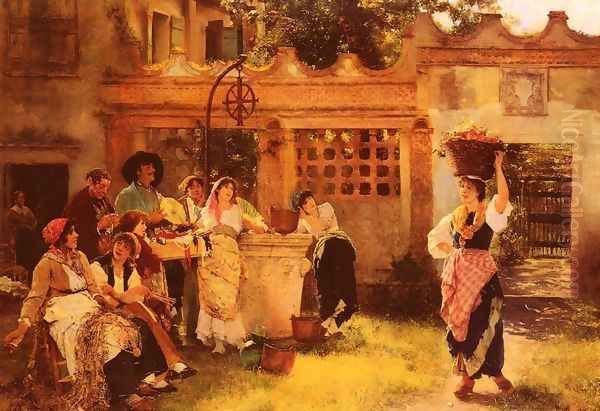
"A Venetian Christening Party" (1896) is another significant work, demonstrating Woods's skill in composing multi-figure scenes with a clear narrative. The painting depicts a joyful family group, dressed in their Sunday best, likely on their way to or from a christening ceremony. The setting, with its characteristic Venetian architecture and canal, provides an authentic backdrop. The expressions and interactions of the figures convey a sense of celebration and community, themes that Woods often explored.
"Cupid's Spell" (1885), purchased by the Chantrey Bequest for the Tate Gallery, is a charming genre scene. It depicts a young Venetian woman consulting a fortune-teller, who is perhaps reading her cards or interpreting some other omen related to love. The painting is rich in detail, from the women's costumes to the domestic setting. It plays on the romantic and slightly mysterious aspects of Venetian life that appealed to the Victorian imagination. The title itself suggests a narrative of love and destiny, common themes in popular art of the period.
"The Course of True Love" (1882) and its companion piece "The Course of True Love Never Did Run Smooth" (exhibited 1883) are examples of Woods's narrative pairings. The first likely depicted a happy couple, while the latter, as its title suggests, would have introduced an element of gentle conflict or a lovers' quarrel. Such narrative sequences were popular, allowing the artist to explore different emotional states and tell a more complete story.
Other characteristic titles that reflect his focus include:
"A Venetian Fan Seller": Capturing a typical street vendor and her wares.
"Sunshine and Shadow": A title that could apply to many of his works, emphasizing his interest in the play of light and the contrasting moods of Venetian life.
"La Promessa Sposa" (The Betrothed): Focusing on themes of courtship and marriage.
"Street in Venice": A common title for his depictions of everyday life in the narrow calli.
"Bargaining for an Old Master" (c. 1886): This work shows Woods's interest in the art and antique trade within Venice, depicting figures examining a painting, perhaps in a dusty shop or a private collection. It reflects the city's rich artistic heritage.
"On the Steps of the Rialto" (1880s): Similar to "At the Foot of the Rialto," this would have focused on the lively human activity around this iconic landmark.
"A Venetian Flower Girl": A recurring subject, allowing Woods to depict youthful beauty and the vibrant colors of the flowers against the backdrop of the city.
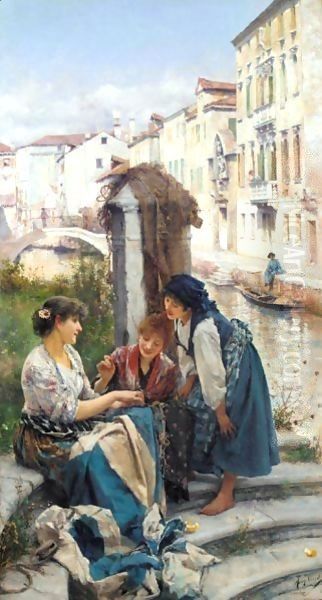
The creative background for all these works was Woods's daily life and observation in Venice. He would have sketched extensively from life, capturing gestures, expressions, and details of costume and setting. These sketches would then be worked up into finished oil paintings in his studio. His models were often local Venetians, and he developed a deep familiarity with their customs and way of life. His aim was to create paintings that were both aesthetically pleasing and offered a glimpse into a world that was exotic yet relatable to his British audience.
Henry Woods's Interactions with Contemporary Painters
Henry Woods's career unfolded within a vibrant and interconnected art world, both in London and among the expatriate community in Venice. His interactions with contemporary painters were numerous and often influential.
The most significant relationship was undoubtedly with Sir Luke Fildes (1843-1927). Their friendship, forged as students at the South Kensington Schools, was lifelong. They worked together as illustrators for The Graphic, shared artistic ambitions, and their families became intertwined when Fildes married Woods's sister, Fanny. Their early joint trip to Venice in 1876 was a turning point for Woods. Fildes himself painted Venetian subjects, particularly in the 1870s and 80s, and their shared experiences in the city likely fostered mutual artistic dialogue. While Fildes later became more famous for his social realist paintings like "Applicants to a Casual Ward" and his society portraits, their early careers ran on parallel tracks.
In London, Woods was part of the circle of artists associated with The Graphic, which included Frank Holl (1845-1888) and Hubert von Herkomer (1849-1914). These artists, like Woods and Fildes, gained early experience in narrative composition and social observation through their illustrative work. Holl and Herkomer became prominent figures in British art, known for their powerful social realist paintings and portraits. While Woods's subject matter diverged towards the picturesque, his foundational training shared common ground with these influential contemporaries.
As a member of the Royal Academy, Woods would have known and interacted with the leading figures of the British art establishment. This included presidents of the Royal Academy like Lord Frederic Leighton (1830-1896) and Sir Edward Poynter (1836-1919), as well as highly successful academic painters like Sir Lawrence Alma-Tadema (1836-1912). These artists represented the pinnacle of Victorian academic painting, and Woods's election to the RA signified his acceptance within this esteemed group. He would have exhibited alongside them in the annual Summer Exhibitions.
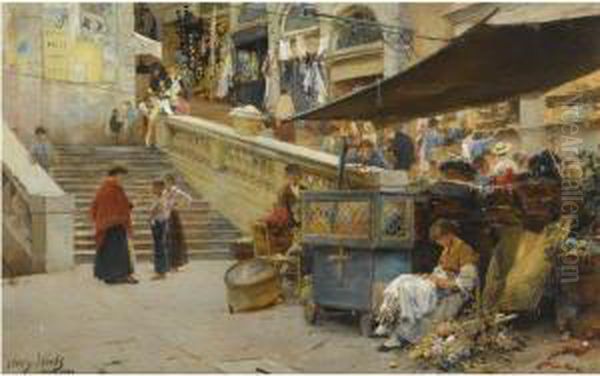
In Venice, Woods was part of a thriving community of international artists. He would have encountered other painters specializing in Venetian scenes, such as the aforementioned Eugene de Blaas and William Logsdail (1859-1944). Logsdail, another British artist, also painted detailed and popular scenes of Venetian life, sometimes on a larger scale, such as his "The Piazza of St. Mark's, Venice." There would have been a degree of friendly rivalry and shared interest among these artists depicting the same beloved city.
The American painter John Singer Sargent (1856-1925) also spent considerable time in Venice, producing a remarkable series of watercolors and oils that captured the city's atmosphere with a more impressionistic and fluid touch than Woods's detailed realism. While their styles differed, they were part of the same expatriate milieu. Similarly, James McNeill Whistler (1834-1903) had a famous period in Venice in 1879-80, producing etchings and pastels that emphasized mood and atmosphere over detailed representation. Woods would have been aware of these different artistic approaches to Venice.
Later, Walter Sickert (1860-1942), a British painter with strong ties to Venice, developed his own distinctive, often darker and more enigmatic, vision of the city. While Sickert's style and subject matter were quite different from Woods's, they represent successive generations of British artists captivated by Venice.
Woods also maintained friendships with other Royal Academicians who might not have specialized in Venetian scenes but were part of his social and professional circle in London. This could include genre painters like Marcus Stone (1840-1921), who was a close friend of Fildes and thus likely knew Woods well.
The interactions were not limited to British or Anglophone artists. Living in Venice for so long, Woods would have known many Italian artists. While specific records of deep friendships with prominent Italian painters like Giovanni Boldini or Antonio Mancini are not as well-documented as his British connections, the artistic community in Venice was relatively cosmopolitan.
These interactions, whether through shared studio spaces, exhibitions, social gatherings, or simply the ambient artistic environment, all contributed to Woods's development and his place within the broader art historical context of the late 19th and early 20th centuries.
Anecdotes or Controversial Events in Henry Woods's Life
Henry Woods's life and career were generally characterized by steady professional success and a relatively quiet private life, rather than by major controversies or scandalous events that sometimes marked the biographies of other artists. He was a respected member of the Royal Academy and his work was consistently popular with the public.

One of the most significant personal narratives in Woods's life revolves around his close connection to the Fildes family. As mentioned, his sister Fanny married Luke Fildes. Tragically, Fanny Fildes died relatively young in 1897. Henry Woods, who was deeply attached to his sister and her children, played an important supportive role for his brother-in-law and his nieces and nephews. This close familial bond was a defining feature of his personal life. Later in life, in 1903, Henry Woods married an Italian artist named Gigi (Luigia) Ceresa. Gigi had been a model for various artists in Venice, including Woods himself and Luke Fildes, and was a friend of the family. This marriage further solidified his ties to Italy.
The decision to live as an expatriate in Venice for most of his adult life was, in itself, a defining characteristic. While many British artists traveled to Italy, fewer made it their permanent home while still maintaining a career focused on the British art market. This dedication to Venice allowed him to immerse himself deeply in its culture and daily rhythms, which is reflected in the authenticity of his genre scenes. His studio in Venice became a well-known spot, and he was a familiar figure in the Anglo-American expatriate community there.
There are no records of major artistic controversies surrounding Woods's work. He was not an avant-garde provocateur challenging artistic conventions. Instead, he worked within the established traditions of academic realism and genre painting, producing works that were admired for their skill, charm, and picturesque qualities. His art was designed to please and engage, rather than to shock or confront. This alignment with prevailing tastes contributed to his steady success but also meant he was less likely to be at the center of artistic debates or scandals.
An anecdote that speaks to the working methods of artists like Woods involves their use of local models. Woods, like Eugene de Blaas and others, would have employed Venetians to pose for their paintings. These models often became familiar faces in their works, contributing to the sense of a recurring cast of characters in their depictions of Venetian life. The relationships between artists and their models could vary, from purely professional arrangements to closer friendships. Woods's eventual marriage to Gigi Ceresa, who had modeled for him, is an example of a deeper connection forming.
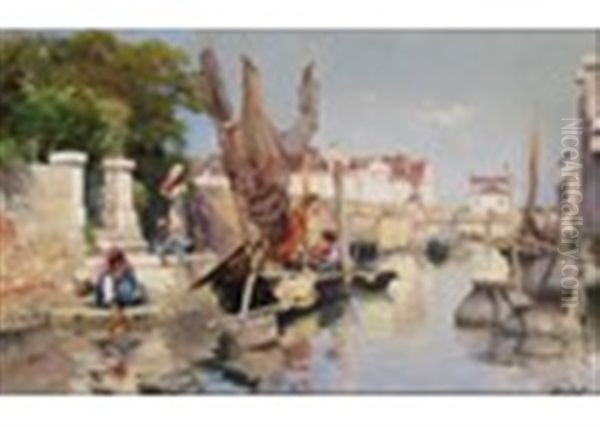
His long and productive career in Venice, coupled with his consistent exhibition record at the Royal Academy, suggests a disciplined and dedicated artist. The "controversy," if any, might be the modern art historical assessment that views his work as charming and skillful but perhaps lacking the innovative power of some of his contemporaries who were pushing the boundaries of art, such as the Impressionists or Post-Impressionists. However, within his chosen field of Venetian genre painting, he was a leading and highly respected practitioner. His life was more one of quiet dedication to his craft and his adopted city than one of dramatic public incident.
Important Exhibitions and Collecting Institutions in Henry Woods's Artistic Career
Henry Woods's artistic career was significantly shaped by his participation in major exhibitions and the acquisition of his works by prominent collecting institutions and private patrons. These were crucial for establishing his reputation and ensuring his financial success.
The Royal Academy of Arts in London was the most important exhibition venue for Henry Woods throughout his career. From his first acceptance, he became a regular and prolific exhibitor at the RA's annual Summer Exhibitions. These exhibitions were major events in the London social and artistic calendar, attracting vast numbers of visitors and critical attention. Success at the RA could make an artist's career. Woods exhibited well over one hundred paintings there between 1869 and 1921. His election as an Associate of the Royal Academy (ARA) in 1882 and as a full Royal Academician (RA) in 1893 were milestones achieved through his consistent and popular contributions to these exhibitions.
Besides the Royal Academy, Woods also exhibited at other London venues, though less frequently. These might have included the Grosvenor Gallery or the New Gallery, which offered alternative spaces for artists, sometimes showcasing works that were slightly more aesthetic or less strictly academic than those typically found at the RA. He also exhibited at regional galleries in Britain, such as the Royal Manchester Institution and the Walker Art Gallery in Liverpool.
Internationally, while his primary focus was the British market, his Venetian scenes would have been suitable for inclusion in international expositions that were common during this period, such as the Paris Salon or various World's Fairs, though his participation in these is less prominently documented than his RA record.
In terms of collecting institutions, several British public galleries acquired works by Henry Woods, often reflecting the taste of the late Victorian and Edwardian eras.
The Tate Gallery (now Tate Britain) in London holds works by Woods, most notably "Cupid's Spell" (1885), which was purchased through the Chantrey Bequest. The Chantrey Bequest was a fund established by the will of sculptor Sir Francis Chantrey to purchase "works of fine art of the highest merit... executed within the shores of Great Britain." The acquisition of a work through the Chantrey Bequest was a significant honor and ensured its place in a national collection. Another work, "The convalescent" (exhibited 1880), was also presented by the Chantrey Trustees.
His hometown gallery, the Warrington Museum & Art Gallery, naturally has an interest in his work and holds examples, reflecting local pride in a successful native son. The Walker Art Gallery in Liverpool, a major regional institution, also has paintings by Woods, indicative of his popularity beyond London. Other regional museums across the United Kingdom that were actively collecting contemporary British art during his lifetime likely acquired his paintings.
A substantial portion of Woods's output went into private collections. His charming and accessible Venetian scenes were highly desirable among the affluent middle and upper classes in Britain, who sought art that was both skillfully executed and offered a pleasing subject matter. These paintings would have adorned the walls of many Victorian homes. The art market of the time was robust, with dealers like Agnew's playing a significant role in connecting artists with buyers.
The enduring presence of his works in these public collections, alongside those held privately, attests to the appeal and success Henry Woods enjoyed during his lifetime. While tastes in art have evolved, these collections preserve his contribution to British art and his particular vision of Venetian life. His paintings continue to be appreciated for their craftsmanship, their narrative charm, and the window they offer onto a bygone era in the life of one of the world's most painted cities.